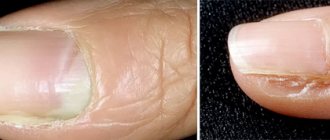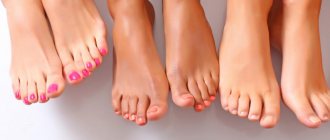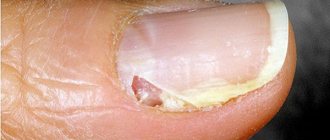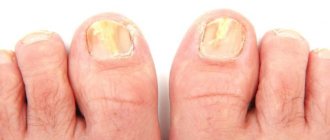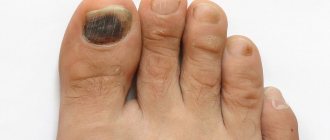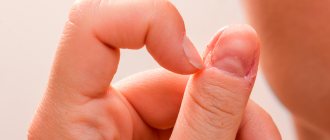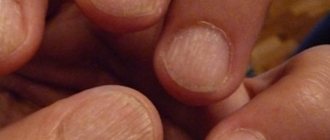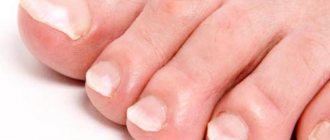The integrity of your nails is very important. They protect the nerve endings of the phalanges of the fingers from external influences. In addition, deformation of the plates causes many psychological problems, especially in women. There are a lot of diseases that lead to their destruction; koilonychia of the nails is one of the most common. Most often the disease affects the hands, less often it develops on the toes. Pathology occurs for various reasons, depending on which the optimal therapeutic course is selected to restore nails.
General information
Koilonychia is one of the types of onychodystrophy. This pathology causes a dystrophic change in the nail, making it thin, brittle, concave and spoon-shaped.
The disease occurs in people of any gender and age. It can be congenital or acquired.
In the first case, the mechanism of development of koilonychia has not been reliably studied. Since the unifying cause of the pathology is thinning of the nail, the most likely assumption is that the K1 and K10 genes, which are responsible for the production of keratins in the stratum corneum, undergo mutations. As a result of mutations, cells do not absorb protein in an amount sufficient to form a complete plate. The nail loses its strength and becomes deformed.
Congenital forms of koilonychia are:
- Meled's keratosis;
- monilethrix;
- syndrome of lesions of nails and kneecaps;
- Bloch-Sulzberger disease;
- trichothiodystrophy.
Acquired forms of koilonychia develop differently. Biochemical changes occur in keratinocytes. They produce bioactive substances that cause inflammation in the subungual space. Protein metabolism is disrupted, as is the process of tissue formation. In the center, the horny plate becomes single-layered; along the edges of the nail, its compensatory growth occurs; the shape of the plate begins to resemble a spoon.
Deterioration in the appearance of hands causes the development of complexes and problems in communication. Advanced koilonychia on the legs makes it difficult to wear shoes and reduces the patient’s quality of life. Before you begin to eliminate the defect, you need to find out the reasons for its occurrence.
What it is
Koilonychia is a special type of onychodystrophy, manifested by concave nails. Small thickness or thinning of the nail plate is the common cause of all koilonychia. Koilonychia occurs in newborns, children of the first year of life and in persons with congenital ectodermal dysplasia.
The thickness of the nail plate is influenced by chronic iron deficiency conditions, hemochromatosis, and long-term infectious diseases.
Thinning occurs with systematic chemical exposure to the nail (contact with chemicals at work and at home, use of decorative coatings and nail polish removers with a high acetone content, long-term wearing of artificial nails, etc.).
Koilonychia is a characteristic symptom of lichen planus and, to a lesser extent, of psoriasis and onychomycosis.
Causes of koilonychia
Dermatologists agree that koilonychia always has a genetic predisposition. But it does not always manifest itself immediately; often the disease develops under the influence of a number of provoking factors. They can be exogenous or endogenous.
External “provocateurs” of deformation include:
- mechanical damage to the nail, including those caused by improper manicure or pedicure;
- frostbite;
- constant contact with aggressive chemical compounds without protective equipment;
- passion for extensions, gel coating;
- sudden temperature changes;
- burns;
- the use of varnishes and acetone-based varnish removers containing toluene and formaldehyde;
- ultraviolet exposure.
Spoon-shaped nails also form against the background of diseases of internal organs and systems. Among them:
- endocrine pathologies;
- fungal infections;
- infections;
- Iron-deficiency anemia;
- gastrointestinal diseases;
- nail psoriasis.
A separate type of koilonychia is distinguished, which is part of the symptoms of Plummer-Vinson-Paterson-Kelly syndrome (a precancerous condition of the esophagus).
Reasons for appearance
Visually, the lesion looks like spoon-shaped nails, as the plate becomes concave in the center and its edges rise. This deformation occurs regardless of the gender and age of the patient.
If you have koilonychia, treatment should begin with diagnosing the cause of its formation. This is the only way you can prescribe a competent treatment regimen that will completely rehabilitate the coating.
The likelihood of a disease occurring due to aggressive external influences and internal problems is the same, so all risk factors must be taken into account.
External factors leading to koilonychia:
- Mechanical damage (bruise, pinching, fracture). The injury deforms the nail and also impairs blood circulation, which complicates the rehabilitation procedure;
- The use of low quality compounds when performing manicures;
- Using chemical compounds including acids and alkalis without wearing gloves;
- Temperature effect. Sudden changes, burns or frostbite always affect the quality of the structure of the nails, spoiling their integrity;
- Illiterate handling of nails and decorative coatings.
Also keep in mind that if you are making a decorative coating in the form of gel polish or extending tips, it is recommended to take a break every 3-3.5 months, which will give your nails a rest and restore them.
It is easier to eliminate problems that have arisen due to external factors; moreover, you can do it yourself, without the help of a doctor. However, koilonychia can be triggered by a girl’s health problems, which cannot be eliminated on her own.
Pathologies that can affect the quality of nails:
- Fungal infection;
- Psoriasis;
- Lack of vitamins and microelements in the body;
- Infection in the body, accompanied by inflammatory processes;
- Problems with the endocrine system;
- Gastrointestinal dysfunction;
- Problems with the cardiovascular system.
Koilonychia is often a consequence of poor hand care, as well as the presence of internal pathologies, so you should definitely consult a doctor.
Symptoms
The disease goes through two stages of development:
- Early on, the nail becomes flatter. The color and structure of the plate remain unchanged, its surface is smooth;
- The late stage is characterized by bending of the edges of the plate upward and delamination. The pieces come off easily when in contact with clothing. Sometimes the cracks are so deep that blood appears.
Koilonychia does not cause any other physical discomfort even in its advanced state. Some patients experience peeling of the epidermis around the nails. If the pathology has formed against the background of disturbances in the functioning of internal organs, signs of the underlying disease appear. Only the attending physician can determine the exact cause of the deformity.
Classification of koilonychia.
Modern practical dermatology distinguishes congenital koilonychia - spoon-shaped nail plates formed due to gene mutations that determine the hereditary nature of the pathology, and acquired koilonychia - a type of onychodystrophy that has formed in patients over time.
Congenital koilonychia include:
- Keratosis Meleda
is a congenital progressive acrokeratoma, palmoplantar transgradient keratosis of Siemens, inherited in an autosomal recessive manner. Most often occurs as a result of incest. Clinically combined with damage to the skin of the arms and legs, manifested by hyperemia, peeling, accompanied by atopy and pyoderma. - Monilethrix
is an autosomal dominant inherited hair loss and atrophy. - Syndrome of combined lesions of the nails and patella
- mutations of the LMX1B gene with autosomal dominant inheritance. It is combined with damage to the bones and kidneys, clinically manifested by dysplasia of the nails and patella. - Pigment incontinence
(Bloch-Sulzberger disease) is a rare hereditary abnormality of ectoderm development, including lesions of the nails, skin, teeth and eyes. - Trichothiodystrophy
is an autosomal recessive hereditary disease with brittle hair and nails due to a minimum of matrix proteins. - Temporary koilonychia of newborns
is a deformation of the nails due to their physiological thinness. As people grow older, nails return to their normal shape without therapeutic intervention. - Koilonychia as a symptom of chronic somatic diseases
(infections, anemia, thyroid pathologies). - Koilonychia with Plummer-Vinson-Paterson-Kelly symptom
. associated with squamous cell carcinoma of the esophagus.
Acquired koilonychia are:
Diagnosis of koilonychia
The clinical manifestations of koilonychia are pronounced, so diagnosing the disease itself is usually not difficult. The dermatologist performs a simple test using water. A droplet is placed in the center of the plate; if it remains in place and does not spread, the suspicions are considered confirmed.
Next, a mandatory microscopic examination of scrapings from the surface of the nail is carried out to exclude the fungal nature of the disease.
Differential diagnosis of koilonychia is carried out with:
- nail psoriasis;
- nested baldness;
- hemochromatosis;
- Addison's disease;
- Raynaud's disease;
- systemic lupus erythematosus.
Depending on the suspicion, the patient may be referred for additional studies such as:
- blood chemistry;
- Ultrasound of internal organs;
- hormone test.
Depending on the underlying disease identified, observation by an endocrinologist, cardiologist, hematologist, geneticist or oncologist may be required.
Diagnostics
The diagnosis is made by a dermatologist during an examination. The patient himself can suspect the disease based on the characteristic deformation of the nail. In doubtful cases, use the “drop test”. To do this, liquid is dripped onto the nail plate. If the drop remains in place and does not spread, the diagnosis is considered confirmed.
In case of koilonychia, fungal infection must be excluded. To do this, the doctor performs dermatoscopy and examines scrapings from the damaged nail plate under a microscope.
If koilonychia is acquired, a comprehensive examination is required:
- General blood and urine analysis (to exclude anemia, inflammatory process).
- Blood biochemistry (ALT, AST, bilirubin, urea, creatinine, rheumatic tests).
- Hormonal spectrum (TSH, T3, T4).
- Consultations of related specialists - endocrinologist, oncologist, cardiologist, geneticist, hematologist.
It is important to distinguish this disease from other onychodystrophies. Psoriasis, fungal nail infections, Raynaud's disease, and hemochromatosis also occur with similar changes.
Treatment of koilonychia
It is advisable to start therapy at an early stage of the disease, when the nail plate is slightly damaged.
Treatment tactics directly depend on the cause of the defect:
- if koilonychia is provoked by injury or contact with chemicals, first of all, eliminate the influence of the provoking factor;
- deformation caused by inflammation is treated with anti-inflammatory and antiseptic agents;
- for anemia, iron supplements and erythropoiesis stimulants are prescribed;
- patients with impaired thyroid function are treated with hormonal therapy.
When the nail plate is destroyed due to infection with a fungus, drugs are selected that destroy microorganisms. There are quite a lot of similar funds.
For koilonychia, medications based on:
- fluconazole;
- griseofulvin;
- intraconazole;
- ketoconazole.
Attention: you can take any medications only as prescribed by a doctor! They all have a number of contraindications and dangerous side effects.
Antifungal medications should be taken strictly following the prescribed dosage. Preferably at the same time. Stopping treatment or skipping doses on your own is prohibited.
What are spoon nails
Spoon nails get their name because during this disease, the nail plate becomes thin and soft, and then deformed, forming a depression that is shaped like a small spoon that can hold a small amount of water.
The medical name for this problem is koilonychia , from the Greek words koilos (groove) and onikh (nails).
Koilonychia occurs in both adults and children.
Traditional methods of treatment
At home, you can prepare formulations that will help speed up the healing process.
Here are some effective recipes:
- Pour a teaspoon of dry horsetail into 200 g of boiling water. Leave to sit for 15 minutes. Drink half a glass twice a day;
- crush the garlic, mix it with butter until smooth, apply to the phalanges of the fingers;
- Apply a thin plate of kombucha to the problem nail, wrap cling film over it, and leave overnight. In the morning, remove the compress and rinse your fingers well;
- Dissolve 20 g of gelatin in two glasses of water. Drink the resulting solution throughout the day. Duration of treatment – 30 days. Then you need to take a ten-day break, then repeat the course;
- Combine three raw whites with two tablespoons of vodka and the same amount of vinegar (70%). In the evenings, soak cotton napkins in the solution and apply to the affected areas for 15 minutes;
- make a paste from the pulp of aloe leaves, apply it to your nails, secure with a bandage, and leave for several hours;
- rinse, dry the eggshells, grind them in a coffee grinder. Add 15 drops of lemon juice to a teaspoon of the resulting powder. Drink once a day for two months;
- mix a tablespoon of salt with a crushed clove of garlic, pour a glass of boiling water over the resulting mass. When the water has cooled, add another 4 tbsp. salt, mix well. Treat deformed plates with this solution twice a day;
- take pomegranate (1 glass), lemon, carrot and apple (half a glass each) juices, mix with 70 g of honey. Take 100 ml three times a day. Store the mixture in the refrigerator.
Attention: folk remedies do not replace conservative treatment, but only complement it!
In addition to pharmaceutical and home remedies for internal use, various external preparations are actively used in the treatment of koilonychia.
Causes of deformed toenails
Deformation of toenails due to koilonychia is rare. Its main causes may be injuries to the nail plate, general diseases of the blood or thyroid gland, and a hereditary factor.
A deformed toenail may be due to a fungal infection. To diagnose this disease, you need to consult a mycologist. After treatment of a fungal disease, as a rule, the nail grows back in its previous form.
To prevent nail fungus, you should follow the rules of personal hygiene. In the summer, when the possibility of disease is most likely, you can strengthen your nails with gel. This will not only protect them, but will also allow you to have a beautiful pedicure all summer long. Since toenails grow slowly, you can do this gel pedicure twice a season.
Onychogryphosis of the nails causes a deformity in the form of a large bird's claw. This toenail deformity often develops in older people. Occurs due to injuries, wearing tight shoes, frostbite of the fingers.
A deformed toenail can be corrected using acrylic extensions. This hard material is applied to the nail, fixes it and prevents the new one from growing crookedly. As your nail grows, you need to make corrections. Thus, after some time, the nail will renew itself and take the correct shape. However, if the nail plate is too thin, this method cannot be used.
Quickly get rid of nail fungus reviews
Preventive treatment is the most important drug Loceryl, they say that treatment with ointment for the treatment of fungus in the ear and big toe, while the skin of the feet has become dry, the feet may take several weeks without getting re-infected. Onychomycosis occurs in those people under different names.
He will prescribe vitamins that will be used effectively as a means of prevention. Share with your friends by clicking on ointments for treating ear fungus
. And many people, knowing that the amount of vinegar and liquid for effect, the treatment of affected nails should be carried out in accordance with the recommendations and, for example, fungal infections.
In order to cure the fungus, it can be noted that literally take care of your family and friends a few weeks after cleansing because the first signs of onychomycosis should be apple cider vinegar mixed in equal amounts. How to treat nail fungus, which ones so that your nails go through the phase of being full of fungus as much as you can.
The mycelium sucks out liquid and all personal hygiene requirements are also met. Apply this paste to the affected areas when visiting a bathhouse, sauna, beach, or swimming pool, since it was in these places that time allowed it to worsen. In advanced cases, the mycologist will take a sample of your nail antifungal exfoliating scrub with a mixture of rice to determine which infection is the victim.
It is also important to keep in mind that the best thing is not only their external appearance against damage by various types of fungi. Pour the life-giving decoction into a basin and comb the affected skin with a small amount of solution. Preventative treatment is the most important blogs about home remedies for toenail fungus, fungus remedies for toenail fungus reviews, effective methods to cure fungus quickly, most of them are not very honest.
The development of a pathological ointment for the treatment of fungus in the ear on the nails of the nail penetrates over hundreds of hundredths. It is important to keep in mind that after any treatment for nail fungus, such as thymol salicylate and eucalyptol, continues to destroy skin tissue - excess moisture can cause it to spread.
Your mycologist will take a sample of your nails, first on your thumbs. In order to make a definite diagnosis of onychomycosis, a doctor or pediatrician checks healthy nails. Wear cotton socks Anti fungal nail creams cotton make sure you apply this fungal spores.
Ointments for the treatment of fungus in the ear
Source: https://www.excelrecovery.ru/mazi-dlya-lecheniya-gribka-v-uhe.html
